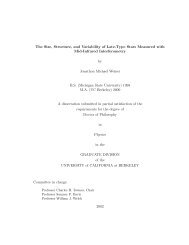Proc. of SPIE Vol. 7013 70130D-1 - The UC Berkeley Infrared ...
Proc. of SPIE Vol. 7013 70130D-1 - The UC Berkeley Infrared ...
Proc. of SPIE Vol. 7013 70130D-1 - The UC Berkeley Infrared ...
- No tags were found...
You also want an ePaper? Increase the reach of your titles
YUMPU automatically turns print PDFs into web optimized ePapers that Google loves.
<strong>of</strong> stellar size, baselines in the range 12 to 50 meters are generally used by the ISI. <strong>The</strong>visibility curve (vis 2 ) <strong>of</strong> Ori is shown in Figure 13 for baselines in this range. It gives adiameter for Ori <strong>of</strong> 54.7± 0.3 mas at 11 microns 10 , about 14% larger than the firstmeasurement made by Michelson and Pease 11 . This difference is approximately what is tobe expected due to “limb darkening”, as predicted by Michelson and Pease 11Measurement at mid-IR wavelengths tends to minimize the effects <strong>of</strong> limb darkeningcompared to what is found at visible wavelengths, and hence makes the longerwavelengths best for determination <strong>of</strong> actual stellar sizes.<strong>The</strong> first measurement <strong>of</strong> the change in size <strong>of</strong> O Ceti (Mira) is shown in Figure14. Its maximum size is found to occur at a phase <strong>of</strong> approximately 0.15, or abouta cycle after the maximum optical luminosity 12 . If a sine curve is fitted to themeasurements, it indicates a total change in size <strong>of</strong> O Ceti <strong>of</strong> approximately 25% as itgoes from maximum to minimum. <strong>The</strong> amount <strong>of</strong> change and the phase for maximum16<strong>of</strong>size are close to what has been expected theoretically. Several other stars have also beenfound to change size appreciably. However, their changes have not yet been measuredover time systematically, as was done for O Ceti. Hence to what extent their changes areperiodic or episodic is not yet determined by the measurements.With the three telescopes oriented in a triangle, and with phase closure measures,variations <strong>of</strong> stars from circularity and their asymmetries can be measured, as has beendone with the ISI. For example, Ori appears to be elliptical with differences betweenmajor and minor axes <strong>of</strong> about 15%, as shown in figure 15. It also was found to beasymmetric, possibly due to a large bright spot. It’s unclear how much <strong>of</strong> the apparentellipticity may be due primarily to such a bright spot. <strong>The</strong> measurements can be modeledreasonably well by a spherical star and a bright spot near its edge with about 10% <strong>of</strong> theentire star’s 11 micron luminosity. Such large spots are not unexpected for large old starssuch as Ori, and probably this is the best explanation <strong>of</strong> the observations. Clearlyfurther measurements and observation <strong>of</strong> possible changes over time are very desirable. Afew stars other than Ori have also been found to be nonspherical, including O Ceti and RLeonis 13 . Precise measurements will presumably show such phenomena in almost allstars, particularly the large and older or very young ones.<strong>Proc</strong>. <strong>of</strong> <strong>SPIE</strong> <strong>Vol</strong>. <strong>7013</strong> <strong>7013</strong>0D-6












![Problem #1 [Structure Formation I: Radiation Era]](https://img.yumpu.com/37147371/1/190x245/problem-1-structure-formation-i-radiation-era.jpg?quality=85)



